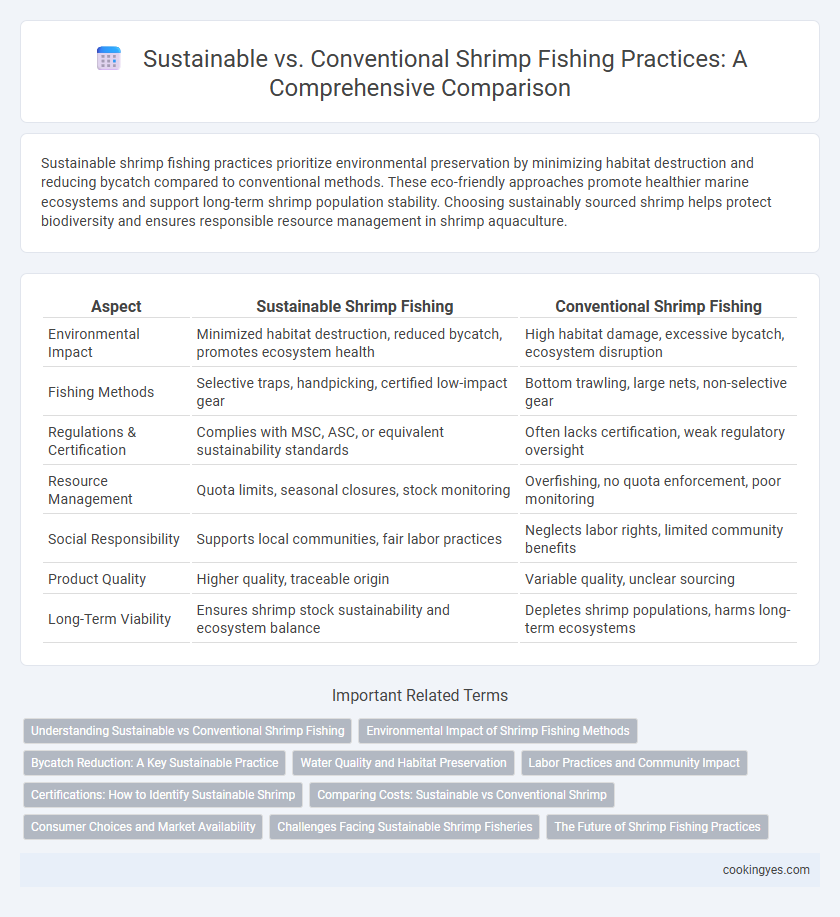Sustainable shrimp fishing practices prioritize environmental preservation by minimizing habitat destruction and reducing bycatch compared to conventional methods. These eco-friendly approaches promote healthier marine ecosystems and support long-term shrimp population stability. Choosing sustainably sourced shrimp helps protect biodiversity and ensures responsible resource management in shrimp aquaculture.
Table of Comparison
| Aspect | Sustainable Shrimp Fishing | Conventional Shrimp Fishing |
|---|---|---|
| Environmental Impact | Minimized habitat destruction, reduced bycatch, promotes ecosystem health | High habitat damage, excessive bycatch, ecosystem disruption |
| Fishing Methods | Selective traps, handpicking, certified low-impact gear | Bottom trawling, large nets, non-selective gear |
| Regulations & Certification | Complies with MSC, ASC, or equivalent sustainability standards | Often lacks certification, weak regulatory oversight |
| Resource Management | Quota limits, seasonal closures, stock monitoring | Overfishing, no quota enforcement, poor monitoring |
| Social Responsibility | Supports local communities, fair labor practices | Neglects labor rights, limited community benefits |
| Product Quality | Higher quality, traceable origin | Variable quality, unclear sourcing |
| Long-Term Viability | Ensures shrimp stock sustainability and ecosystem balance | Depletes shrimp populations, harms long-term ecosystems |
Understanding Sustainable vs Conventional Shrimp Fishing
Sustainable shrimp fishing practices prioritize ecosystem health by using selective gear that reduces bycatch and habitat damage, ensuring shrimp populations remain stable for future harvests. Conventional methods often rely on intensive trawling, which can deplete shrimp stocks rapidly and cause significant harm to marine environments through habitat destruction and high bycatch rates. Understanding the differences between these approaches highlights the importance of adopting sustainable shrimp fisheries to maintain biodiversity and long-term economic viability.
Environmental Impact of Shrimp Fishing Methods
Sustainable shrimp fishing methods prioritize minimizing habitat destruction through selective gear like bycatch reduction devices and turtle excluder devices, significantly reducing bycatch and preserving marine biodiversity. Conventional shrimp fishing often relies on trawling, which disrupts seafloor ecosystems, causing sediment resuspension and damaging coral reefs and seagrass beds. Implementing sustainable practices decreases carbon emissions and helps maintain ecological balance, promoting healthier ocean habitats.
Bycatch Reduction: A Key Sustainable Practice
Sustainable shrimp fishing practices prioritize bycatch reduction through the use of specialized gear such as turtle excluder devices (TEDs) and bycatch reduction devices (BRDs), which minimize the capture of non-target species and help maintain marine biodiversity. Conventional shrimp fishing often results in high levels of bycatch, including endangered species and juvenile fish, leading to significant ecosystem disruption and decreased fish populations. Implementing sustainable methods not only protects aquatic habitats but also supports long-term shrimp stock viability and fishery resilience.
Water Quality and Habitat Preservation
Sustainable shrimp fishing prioritizes water quality by minimizing chemical pollutants and reducing sediment disruption, preserving aquatic ecosystems essential for marine biodiversity. Conventional shrimp practices often result in habitat destruction through trawling, leading to increased turbidity and degradation of seagrass beds and coral reefs. Effective sustainable methods incorporate eco-friendly gear and selective harvesting techniques that maintain habitat integrity and support long-term water filtration processes.
Labor Practices and Community Impact
Sustainable shrimp fishing practices prioritize fair labor standards, ensuring safe working conditions and equitable wages for fishermen, which helps combat exploitation common in conventional shrimp fisheries. These methods also support local communities by promoting economic resilience and preserving marine ecosystems, unlike traditional practices that often lead to environmental degradation and social inequities. Emphasizing traceability and certification, sustainable shrimp fisheries foster transparency and accountability, benefiting both human rights and ecological balance.
Certifications: How to Identify Sustainable Shrimp
Look for certifications like the Marine Stewardship Council (MSC) and Aquaculture Stewardship Council (ASC) labels, which indicate shrimp sourced from sustainable fishing or farming practices that minimize environmental impact. These certifications ensure measures such as bycatch reduction, habitat preservation, and responsible feed use are followed, distinguishing them from conventional shrimp caught with methods that often cause overfishing and ecosystem damage. Checking product packaging or retailer information for these certifications helps consumers make informed choices supporting ocean health and sustainable seafood markets.
Comparing Costs: Sustainable vs Conventional Shrimp
Sustainable shrimp fishing practices often involve higher upfront costs due to eco-friendly gear and certification fees but can reduce long-term expenses through improved resource management and ecosystem health. Conventional shrimp fishing typically has lower immediate costs but risks increased losses from habitat degradation and stock depletion, impacting future yields. Investing in sustainable methods supports economic resilience by balancing operational expenses with environmental preservation.
Consumer Choices and Market Availability
Sustainable shrimp fishing practices prioritize eco-friendly methods such as selective nets and habitat protection, which reduce bycatch and support long-term marine biodiversity, appealing to environmentally conscious consumers. Conventional shrimp fishing often uses trawling techniques that can damage ecosystems but supply larger volumes at lower costs, influencing market availability with more affordable options. Increasing consumer demand for sustainably sourced shrimp drives retailers to expand eco-certified products, gradually shifting market availability toward responsible seafood choices.
Challenges Facing Sustainable Shrimp Fisheries
Sustainable shrimp fisheries grapple with bycatch reduction, habitat degradation, and ensuring shrimp populations remain viable amid fishing pressures. Conventional shrimp practices often contribute to mangrove destruction and overfishing, exacerbating ecological imbalance. Addressing these challenges requires implementing selective gear technology, enforcing regulatory policies, and promoting community engagement to safeguard marine biodiversity.
The Future of Shrimp Fishing Practices
Sustainable shrimp fishing practices prioritize ecosystem health by employing techniques like bycatch reduction devices and habitat-conscious trawling, significantly reducing environmental impact compared to conventional methods that often cause habitat destruction and overfishing. Advancements in aquaculture, such as integrated multi-trophic systems and biofloc technology, are transforming shrimp production by enhancing water quality and reducing reliance on wild stocks. The future of shrimp fishing hinges on adopting these innovations, supported by regulatory frameworks and consumer demand for eco-certified seafood.
Sustainable vs Conventional for shrimp fishing practices Infographic

 cookingyes.com
cookingyes.com